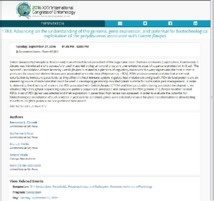Advancing on the understanding of the genome, gene expression, and potential for biotechnological exploitation of the polydnavirus associated with Cotesia flavipes.
Advancing on the understanding of the genome, gene expression, and potential for biotechnological exploitation of the polydnavirus associated with Cotesia flavipes.
Author(s): CÔNSOLI, F. L.; ROSSI, G. G.; MERLIN, B. L.; PRADO, S. de S.; DOSSI, F. C. A.
Summary: Cotesia flavipes (Hymenoptera, Braconidae) in an efficient larval parasitoid of the sugarcane borer Diatraea saccharalis (Lepidoptera, Crambidae). C. flavipes was introduced and is successfully used in applied biological control programs over extensive areas of sugarcane production in Brazil. The successful exploitation of host larvae by Cotesia flavipes is related to a plethora of regulatory molecules this wasp injects into the host or that is produced by parasitoid-derived tissues and associated symbiotic virus (Polydnavirus ? PDV). PDVs produce several proteins that allow host colonization by immature parasitoids, as they affect the host immune system, regulate host metabolism and growth. PDV-derived proteins are an interesting source of molecules that could be used in developing genetically-modified plants suitable for sustainable pest management. In order to determine the diversity of proteins the PDV associated with Cotesia flavipes (CfPDV) and their production during parasitoid development, we obtained high throughput sequencing data and partially sequenced, annotated and compared the PDV genome of C. flavipes to other related PDVs. A set of PDV genes was selected and their expression in parasitized host larvae was assessed. In order to evaluate the potential for biotechnological exploitation of such proteins in pest control, candidate genes were selected and used for plant transformation to allow testing the effects of CfPDV proteins on non-preferred host insects.
Publication year: 2016
Types of publication: Abstract in annals or event proceedings
Unit: Embrapa Environment
Keywords: Cotesia flavipes, Genoma, Polydnaviridae
Observation
Some of Embrapa's publications are published as ePub files. To read them, use or download one of the following free software options to your computer or mobile device. Android: Google Play Books; IOS: iBooks; Windows and Linux: Calibre.
Access other publications
Access the Agricultural Research Database (BDPA) to consult Embrapa's full library collection and records.
Visit Embrapa Bookstore to purchase books and other publications sold by Embrapa.

